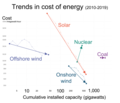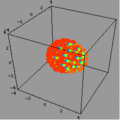Portal:Nuclear technology
The Nuclear Technology Portal
Introduction

- Nuclear technology is technology that involves the nuclear reactions of atomic nuclei. Among the notable nuclear technologies are nuclear reactors, nuclear medicine and nuclear weapons. It is also used, among other things, in smoke detectors and gun sights. (Full article...)
- Nuclear power is the use of nuclear reactions to produce electricity. Nuclear power can be obtained from nuclear fission, nuclear decay and nuclear fusion reactions. Presently, the vast majority of electricity from nuclear power is produced by nuclear fission of uranium and plutonium in nuclear power plants. Nuclear decay processes are used in niche applications such as radioisotope thermoelectric generators in some space probes such as Voyager 2. Generating electricity from fusion power remains the focus of international research. (Full article...)
- A nuclear weapon is an explosive device that derives its destructive force from nuclear reactions, either fission (fission bomb) or a combination of fission and fusion reactions (thermonuclear bomb), producing a nuclear explosion. Both bomb types release large quantities of energy from relatively small amounts of matter. (Full article...)
General images -
Selected article -
Windscale Pile No. 1 became operational in October 1950 followed by Pile No. 2 in June 1951. They were intended to last five years, but operated for seven until shut down following the Windscale fire on 10 October 1957. Nuclear decommissioning operations commenced in the 1980s and are estimated to last beyond 2040. Visible changes have been seen as the chimneys were slowly dismantled from top-down; Pile 2's chimney being reduced to the height of adjacent buildings in the early 2000s. However, the demolition of pile 1 chimney has taken much longer as it was significantly contaminated after the 1957 fire. The reactor cores still remain to be dismantled. (Full article...)
Selected picture -
Attribution: The Ames Laboratory, USDOE (http://www.ameslab.gov/)
Did you know?
- ... that Project Carryall proposed the detonation of 23 nuclear devices in California to build a road?
- ... that Project Ketch proposed the detonation of a 24-kiloton nuclear device in Pennsylvania to create a natural-gas storage reservoir?
- ... that in 1958 the Scyla theta pinch device was the first to demonstrate controlled nuclear fusion in the laboratory?
- ... that campaigning by climate activist Kimiko Hirata halted plans to build 17 new coal-fired power plants following the Fukushima nuclear disaster in Japan?
- ... that the Russian and Belarussian military exercise Zapad 2009 involved nuclear-capable ballistic missiles?
- ... that the sodium fast reactor Fermi 1 suffered a nuclear meltdown that led one operator to suggest "we almost lost Detroit"?
Related WikiProjects
Things you can do
| Parts of this portal (those related to section) need to be updated. Please help update this portal to reflect recent events or newly available information. Relevant discussion may be found on the talk page. (September 2021) |
Selected biography -
Frank Harold Spedding (22 October 1902 – 15 December 1984) was a Canadian-American chemist. He was a renowned expert on rare earth elements, and on extraction of metals from minerals. The uranium extraction process helped make it possible for the Manhattan Project to build the first atomic bombs.
A graduate of the University of Michigan and University of California, Berkeley, Spedding became an assistant professor and head of the department of physical chemistry at Iowa State College in 1937. His efforts at building up the school were so successful that he would spend the rest of his career there, becoming a professor of chemistry in 1941, a professor of physics in 1950, a professor of metallurgy in 1962, and ultimately professor emeritus in 1973. He co-founded, along with Dr. Harley Wilhelm, the Institute for Atomic Research and the Ames Laboratory of the Atomic Energy Commission, and directed the Ames Laboratory from its founding in 1947 until 1968.
Spedding developed an ion-exchange method of separating and purifying rare earth elements using ion-exchange resins, and later used ion exchange to separate isotopes of individual elements, including hundreds of grams of almost pure nitrogen-15. He published over 250 peer-reviewed papers, and held 22 patents in his own name and jointly with others. Some 88 students received their Ph.D. degree under his supervision. (Full article...)
Nuclear technology news
- 20 September 2024 – Russian invasion of Ukraine
- Zaporizhzhia Nuclear Power Plant crisis
- Russian management at the Zaporizhzhia Nuclear Power Plant accuses the Armed Forces of Ukraine of creating threats to the plant's safety by launching a drone to attack a nearby electrical substation. (Reuters)
Related portals
Related topics
Subcategories
Associated Wikimedia
The following Wikimedia Foundation sister projects provide more on this subject:
-
Commons
Free media repository -
Wikibooks
Free textbooks and manuals -
Wikidata
Free knowledge base -
Wikinews
Free-content news -
Wikiquote
Collection of quotations -
Wikisource
Free-content library -
Wikiversity
Free learning tools -
Wiktionary
Dictionary and thesaurus





































































































